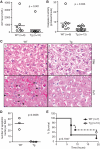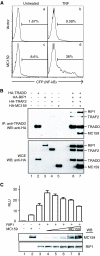Viral cell death inhibitor MC159 enhances innate immunity against vaccinia virus infection
- PMID: 20702623
- PMCID: PMC2950582
- DOI: 10.1128/JVI.00983-10
Viral cell death inhibitor MC159 enhances innate immunity against vaccinia virus infection
Abstract
Viral inhibitors of host programmed cell death (PCD) are widely believed to promote viral replication by preventing or delaying host cell death. Viral FLIPs (Fas-linked ICE-like protease [FLICE; caspase-8]-like inhibitor proteins) are potent inhibitors of death receptor-induced apoptosis and programmed necrosis. Surprisingly, transgenic expression of the viral FLIP MC159 from molluscum contagiosum virus (MCV) in mice enhanced rather than inhibited the innate immune control of vaccinia virus (VV) replication. This effect of MC159 was specifically manifested in peripheral tissues such as the visceral fat pad, but not in the spleen. VV-infected MC159 transgenic mice mounted an enhanced innate inflammatory reaction characterized by increased expression of the chemokine CCL-2/MCP-1 and infiltration of γδ T cells into peripheral tissues. Radiation chimeras revealed that MC159 expression in the parenchyma, but not in the hematopoietic compartment, is responsible for the enhanced innate inflammatory responses. The increased inflammation in peripheral tissues was not due to resistance of lymphocytes to cell death. Rather, we found that MC159 facilitated Toll-like receptor 4 (TLR4)- and tumor necrosis factor (TNF)-induced NF-κB activation. The increased NF-κB responses were mediated in part through increased binding of RIP1 to TNFRSF1A-associated via death domain (TRADD), two crucial signal adaptors for NF-κB activation. These results show that MC159 is a dual-function immune modulator that regulates host cell death as well as NF-κB responses by innate immune signaling receptors.
Figures






References
-
- Balachandran, S., T. Venkataraman, P. B. Fisher, and G. N. Barber. 2007. Fas-associated death domain-containing protein-mediated antiviral innate immune signaling involves the regulation of Irf7. J. Immunol. 178:2429-2439. - PubMed
-
- Benedict, C. A., P. S. Norris, and C. F. Ware. 2002. To kill or be killed: viral evasion of apoptosis. Nat. Immunol. 3:1013-1018. - PubMed
-
- Bertin, J., R. C. Armstrong, S. Ottilie, D. A. Martin, Y. Wang, S. Banks, G. H. Wang, T. G. Senkevich, E. S. Alnemri, B. Moss, M. J. Lenardo, K. J. Tomaselli, and J. I. Cohen. 1997. Death effector domain-containing herpesvirus and poxvirus proteins inhibit both Fas- and TNFR1-induced apoptosis. Proc. Natl. Acad. Sci. U. S. A. 94:1172-1176. - PMC - PubMed
-
- Bukowski, J. F., B. A. Woda, S. Habu, K. Okumura, and R. M. Welsh. 1983. Natural killer cell depletion enhances virus synthesis and virus-induced hepatitis in vivo. J. Immunol. 131:1531-1538. - PubMed
Publication types
MeSH terms
Substances
Grants and funding
LinkOut - more resources
Full Text Sources
Research Materials
Miscellaneous

